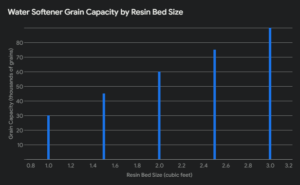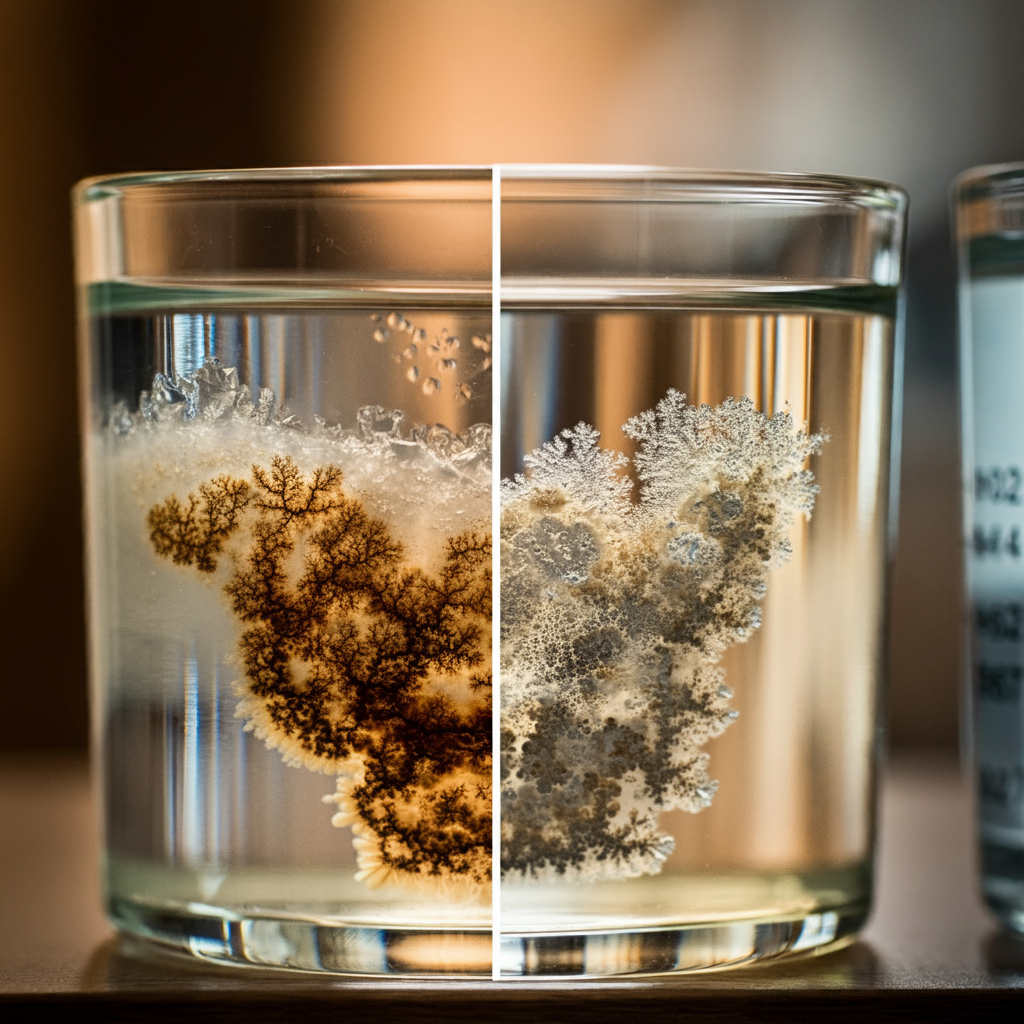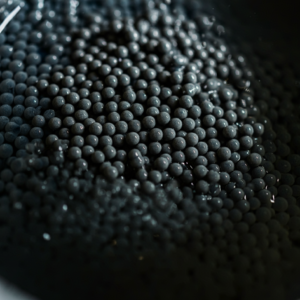The difference between water softener grain capacity and flow rate lies in their distinct functions:
- Grain capacity is the total amount of hardness minerals a softener can remove before needing to regenerate (clean itself). This is typically measured in grains, with one grain equivalent to 1/7000th of a pound of calcium carbonate.
- Flow rate is the amount of softened water the system can deliver per minute, usually expressed in gallons per minute (gpm). It determines how well the softener keeps up with your household’s water demand during peak usage.
Understanding both of these factors is crucial when choosing the right water softener for your home. Hard water, caused by elevated levels of minerals like calcium and magnesium, is a common problem across the United States, affecting an estimated 85% of households. It leads to issues like soap scum buildup, dry skin and hair, spotty dishes, and even shortened lifespans for water-using appliances. Water softeners, like those offered by reputable brands such as SoftPro, Culligan, Kinetico, and Fleck, address this problem by removing the hardness minerals through a process called ion exchange. However, not all water softeners are created equal. A softener with a large grain capacity but low flow rate may struggle to keep up with demand, leading to fluctuations in water pressure and potentially leaving you with hard water during peak usage times. Conversely, a softener with a high flow rate but low grain capacity may regenerate too often, consuming excess salt and increasing operating costs. At WaterSoftenerSizing.com, we understand the importance of finding the right balance between grain capacity and flow rate for your specific needs. Our expert team can help you determine the optimal size and features for your household, ensuring you enjoy the benefits of soft water without any compromises. In this article, we’ll delve deeper into grain capacity and flow rate, explaining how they work, why they matter, and how to choose the right values for your home. By the end, you’ll be equipped with the knowledge to make an informed decision and select a water softener that truly meets your needs.
What is Water Softener Grain Capacity?
Grain capacity is the total amount of hardness minerals a water softener can remove before it needs to regenerate. This is a critical factor in determining how often your softener will need to use salt and water to clean itself, a process also known as regeneration.
Understanding Grains as a Measurement
The grain capacity of a water softener is measured in grains. One grain is a unit of weight equivalent to 1/7000th of a pound of calcium carbonate. The higher the grain capacity, the more hardness minerals the softener can remove before needing regeneration. To put this in perspective, a softener with a 32,000-grain capacity can remove 32,000 grains of hardness minerals before it needs to regenerate. This is roughly equivalent to removing 4.57 pounds of calcium carbonate.
The Role of Resin in Grain Capacity
The grain capacity of a water softener is directly related to the amount and type of resin it contains. Resin, typically small plastic beads, is the heart of a water softener and facilitates the ion exchange process. During this process, the resin beads attract and hold onto the calcium and magnesium ions in your water, replacing them with sodium ions. As the resin beads fill up with calcium and magnesium, their ability to soften water decreases. Regeneration flushes these minerals out, restoring the resin’s capacity.
Factors Affecting Grain Capacity
Several factors influence the grain capacity of a water softener:
- Amount of resin: The more resin a softener contains, the higher its grain capacity. This is why larger households often require softeners with larger resin tanks.
- Type of resin: Different types of resin have varying levels of efficiency. High-capacity resin can remove more hardness minerals per regeneration cycle compared to standard resin.
- Regeneration settings: The salt dosage and frequency of regeneration can also impact the amount of hardness removed per cycle. Higher salt dosages can increase the amount of hardness removed, but can also lead to higher salt consumption.
By understanding these factors, you can choose a water softener with a grain capacity that matches your household’s water hardness and usage, minimizing the frequency of regeneration and optimizing salt efficiency.
Why Grain Capacity Matters
Choosing a water softener with the right grain capacity is crucial for several reasons:
- Efficiency: A softener with insufficient grain capacity will regenerate too often, leading to wasted water and salt.
- Effectiveness: Frequent regenerations can leave your home with hard water between cycles, negating the benefits of softened water.
- Convenience: A properly sized softener will regenerate less frequently, requiring less maintenance and attention.
- Cost: Oversized softeners can be more expensive upfront and may consume more salt than necessary, increasing operating costs.
How to Determine the Right Grain Capacity for Your Home
Choosing the correct grain capacity for your water softener is essential to ensure optimal performance and avoid unnecessary salt and water wastage. To make an informed decision, you need to consider two key factors: water hardness level and daily water usage.
Water Hardness Level
The first step is to determine the hardness of your water. This is typically measured in grains per gallon (gpg) or parts per million (ppm). Water hardness varies widely across the United States, with some regions experiencing levels as high as 30 gpg or more. You can test your water hardness using a home test kit or by contacting your local water utility or a water treatment professional. These tests will provide you with an accurate measurement of your water hardness, allowing you to calculate the appropriate grain capacity for your softener. Typical Grain Capacity Needs Based on Hardness and Household Size
| Water Hardness (gpg) | Household Size (people) | Estimated Daily Water Usage (gallons) | Minimum Grain Capacity Needed |
| 1-3 | 1-2 | 50-100 | 10,000-20,000 |
| 4-7 | 2-3 | 100-150 | 20,000-30,000 |
| 8-10 | 3-4 | 150-200 | 30,000-40,000 |
| 11-15 | 4-5 | 200-250 | 40,000-50,000 |
| 16+ | 5+ | 250+ | 50,000+ |
This table provides a general guideline, but it’s important to note that individual needs may vary. Factors like specific appliances, such as high-efficiency washing machines, or unusual water usage patterns can influence the required grain capacity.
Daily Water Usage
In addition to water hardness, your daily water usage plays a significant role in determining the necessary grain capacity. The more water your household uses, the higher the grain capacity you’ll need to avoid frequent regenerations. You can estimate your daily water usage by using online calculators or by referring to average household figures. The Water Quality Association (WQA), a leading industry organization, estimates that the average person uses approximately 80-100 gallons of water per day. By combining your water hardness level and estimated daily water usage, you can calculate the minimum grain capacity needed for your water softener. However, it’s often recommended to choose a softener with a slightly higher capacity than the minimum to account for fluctuations in usage and ensure optimal performance.
What is Water Softener Flow Rate?
The flow rate of a water softener refers to the amount of softened water it can deliver per minute. It is typically measured in gallons per minute (gpm) and indicates how effectively the softener can supply soft water to your home during periods of high demand.
Flow Rate and Water Pressure
Flow rate is closely linked to water pressure. Adequate flow rate ensures that you have sufficient water pressure even when multiple faucets or appliances are in use simultaneously. For instance, if you’re running the dishwasher, taking a shower, and washing clothes all at once, a high flow rate water softener will ensure that each of these activities receives enough water without a noticeable drop in pressure.
Factors Influencing Flow Rate
Several factors influence the flow rate of a water softener:
- Softener Design: The design and internal components of the softener play a significant role. Some models feature larger valve assemblies or bypass valves that allow for increased water flow.
- Pipe Size: The diameter of the pipes connecting your softener to your home’s plumbing system can impact flow rate. Smaller pipes can restrict water flow, even if the softener itself has a high flow rate capability.
- Water Pressure: The incoming water pressure from your municipality or well affects the softener’s flow rate. If you have naturally low water pressure, it can limit the softener’s ability to deliver water at a high flow rate.
Why Flow Rate Matters
Choosing a water softener with the right flow rate is essential for several reasons:
- Water Pressure: Insufficient flow rate can lead to a noticeable drop in water pressure, particularly during peak usage times. This can be frustrating and inconvenient, especially in households with multiple occupants.
- Appliance Performance: Some appliances, like dishwashers and washing machines, require a certain flow rate to function optimally. A low flow rate can hinder their performance and lead to longer cycle times or unsatisfactory results.
- Comfort: A sufficient flow rate ensures a comfortable and enjoyable experience when using water in your home, whether you’re showering, washing your hands, or filling a bathtub.
By understanding the factors that influence flow rate and how it impacts your daily water usage, you can select a water softener that provides adequate flow to meet your household’s needs. 
Choosing the Right Flow Rate for Your Home
To determine the appropriate flow rate for your water softener, consider the following factors:
- Household Size and Peak Demand: Larger households with multiple bathrooms and appliances typically require higher flow rates to accommodate simultaneous water usage. It’s important to estimate your peak demand, which is the maximum amount of water you’re likely to use at any given time. This can be calculated by adding up the flow rates of the appliances and fixtures you expect to use simultaneously.
- Water Pressure: Test your incoming water pressure using a pressure gauge. If you have low water pressure (below 40 psi), you may need a water softener with a higher flow rate or consider additional solutions like a booster pump to increase pressure.
As a general guideline, a flow rate of 8-12 gpm is sufficient for most households. However, if you have a larger home or anticipate high water usage, you may need a softener with a flow rate of 15 gpm or higher.
The Relationship Between Grain Capacity and Flow Rate
Grain capacity and flow rate are not independent of one another. They represent two sides of the same coin when it comes to water softener performance. While grain capacity determines how much hardness a softener can remove, flow rate dictates how quickly it can deliver softened water to your home.
Striking the Right Balance
The ideal water softener strikes a balance between these two factors. A softener with a large grain capacity but low flow rate may not be able to provide enough soft water during peak demand periods. For example, a family of five taking simultaneous showers may experience a drop in water pressure if their softener has insufficient flow rate, even if it has a high grain capacity. Conversely, a softener with a high flow rate but low grain capacity may regenerate too often. This can lead to increased salt and water usage, as well as potential interruptions in soft water availability between regeneration cycles. Imagine a household with moderate water hardness but high water usage due to multiple appliances and fixtures. If they choose a softener with a low grain capacity, it may need to regenerate every few days, consuming more salt and resources than necessary. On the other hand, a household with very hard water but low water usage may not need a high flow rate softener. A model with a lower flow rate but sufficient grain capacity would be more suitable for their needs, as they are less likely to experience peak demand scenarios.
Choosing the Right Combination
Finding the right combination of grain capacity and flow rate is essential for optimal water softener performance. At WaterSoftenerSizing.com, we can help you analyze your water hardness, daily usage, and peak demand to determine the ideal specifications for your home. For example, a family of four with moderately hard water (8 gpg) and average water usage (150 gallons per day) might require a softener with a 32,000-grain capacity and a flow rate of 10 gpm. This combination would ensure that the softener can handle their daily hardness removal needs while providing sufficient flow to meet peak demand. However, a larger household with very hard water (15 gpg) and high water usage (250 gallons per day) might need a softener with a 48,000-grain capacity and a 15 gpm flow rate. This larger capacity and higher flow rate would be necessary to maintain soft water availability and adequate pressure even during peak usage.
Additional Considerations When Choosing a Water Softener
While grain capacity and flow rate are essential considerations when choosing a water softener, they are not the only factors to consider. Additional features, such as the type of softener (salt-based or salt-free), regeneration type, and smart features, can also significantly impact the performance, convenience, and cost of your water softener.
Salt-Based vs. Salt-Free Water Softeners
- Salt-Based Softeners: These are the most common type of water softeners and utilize an ion exchange process to remove hardness minerals. They require regular replenishment of salt, typically sodium chloride or potassium chloride, to regenerate the resin beads.
- Salt-Free Softeners: Also known as water conditioners, these systems do not remove hardness minerals but instead alter their structure to prevent them from forming scale. They do not require salt but may not be as effective in softening water as salt-based softeners.
The choice between salt-based and salt-free softeners often depends on individual preferences and specific needs. Salt-based softeners are generally more effective in removing hardness minerals, while salt-free systems are a good option for those who wish to avoid adding sodium to their water or have concerns about salt discharge into the environment.
Regeneration Types
Water softeners regenerate, or clean themselves, using different methods:
- Time-Initiated Regeneration: These softeners regenerate on a pre-set schedule, typically every few days. While convenient, they may not always be efficient as they may regenerate even if the resin is not fully exhausted.
- Demand-Initiated Regeneration (DIR): DIR softeners monitor water usage and regenerate only when necessary, based on actual hardness removal. This can save salt and water, making them more efficient and cost-effective in the long run.
If you have a variable water usage pattern, a demand-initiated regeneration softener may be a better choice as it can adapt to your specific needs and avoid unnecessary regeneration cycles.
Smart Features
Many modern water softeners come equipped with smart features that enhance convenience, efficiency, and monitoring capabilities:
- Wi-Fi Connectivity: This allows you to monitor and control your softener remotely using a smartphone app.
- Usage Monitoring: Track your water usage patterns and receive alerts when the softener is approaching regeneration.
- Salt Level Monitoring: Get notifications when the salt level is low and needs refilling.
- Leak Detection: Some softeners can detect leaks and automatically shut off water flow to prevent damage.
These smart features can provide valuable insights into your water usage and softener performance, helping you optimize settings and identify potential issues early on.
Making the Right Choice: Your Path to Softer Water
Understanding the difference between water softener grain capacity and flow rate is crucial for selecting a system that effectively addresses your home’s hard water issues. Grain capacity determines how much hardness the softener can remove before regeneration, while flow rate ensures adequate water pressure during peak usage. By carefully considering your water hardness, daily usage, household size, and peak demand, you can find the perfect balance between these two factors. Choosing a softener with the right grain capacity and flow rate will ensure optimal performance, efficiency, and convenience, providing you with the benefits of soft water without any compromises.
Key Takeaways
- Grain capacity is the total amount of hardness minerals a softener can remove before regeneration.
- Flow rate is the amount of softened water the system can deliver per minute.
- Water hardness and daily usage are the primary factors influencing grain capacity needs.
- Household size and peak demand determine the required flow rate.
- Salt-based softeners use salt to remove hardness minerals, while salt-free softeners condition water to prevent scale buildup.
- Demand-initiated regeneration is more efficient than time-initiated regeneration as it regenerates only when necessary.
- Smart features like Wi-Fi connectivity, usage monitoring, and salt level alerts enhance convenience and efficiency.
Choosing the right water softener is an investment in your home’s comfort, appliance longevity, and overall water quality. By understanding the key factors involved and seeking expert advice, you can make an informed decision and enjoy the benefits of soft water for years to come.
Ready to transform your water and your home?
Visit WaterSoftenerSizing.com today and utilize our free water softener sizing calculator to determine the ideal system for your needs. Our team of experts is also available to answer your questions and guide you through the selection process, ensuring you find the perfect softener for your unique requirements.

Craig “The Water Guy” Phillips is the founder of Quality Water Treatment (QWT) and creator of SoftPro Water Systems.
With over 30 years of experience, Craig has transformed the water treatment industry through his commitment to honest solutions, innovative technology, and customer education.
Known for rejecting high-pressure sales tactics in favor of a consultative approach, Craig leads a family-owned business that serves thousands of households nationwide.
Craig continues to drive innovation in water treatment while maintaining his mission of “transforming water for the betterment of humanity” through transparent pricing, comprehensive customer support, and genuine expertise.
When not developing new water treatment solutions, Craig creates educational content to help homeowners make informed decisions about their water quality.



